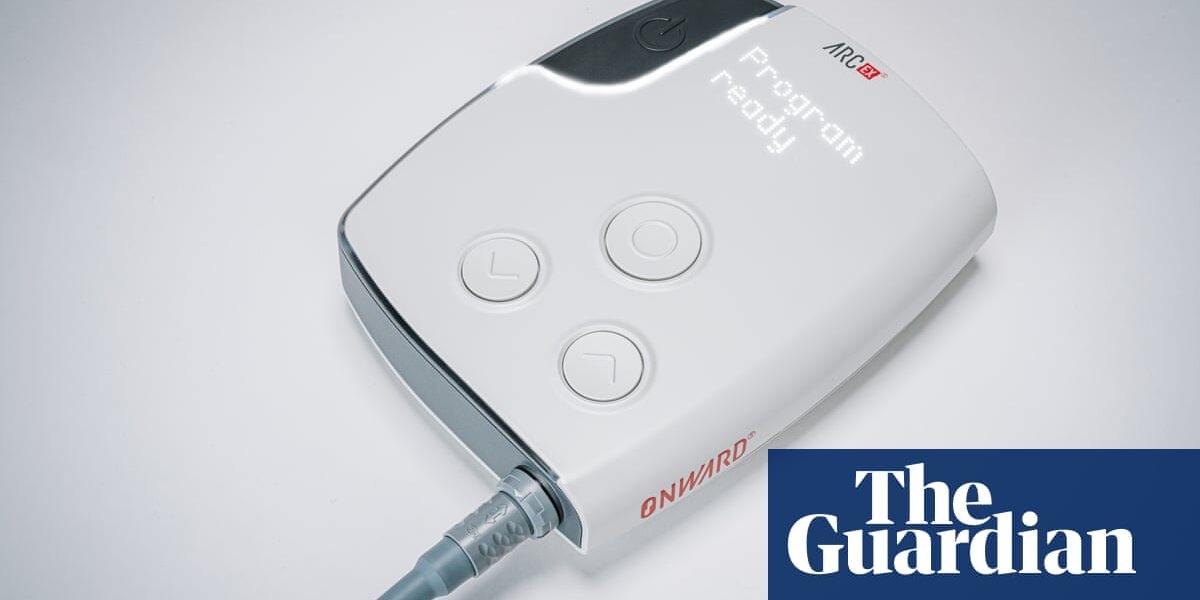
A device that stimulates the spinal nerves with electrical pulses appears to boost how well people recover from major spinal cord injuries, doctors say.
An international trial found that patients who had lost some or all use of their hands and arms after a spinal cord injury regained strength, control and sensation when the stimulation was applied during standard rehabilitation exercises.
The improvements were small but were described by doctors and patients as life-changing because of the impact they had on the patients’ daily routines and quality of life.
“It actually makes it easier for people to move, including people who have complete loss of movement in their hands and arms,” said Prof Chet Moritz, in the department of rehabilitation medicine at the University of Washington in Seattle.
“The benefits accumulate gradually over time as we pair this spinal stimulation with intensive therapy of the hands and arms, such that there are benefits even when the stimulator is turned off.”
Rather than being implanted, the Arc-Ex device is worn externally and uses electrodes that are placed on the skin near the section of the spinal cord responsible for controlling a particular movement or function.
The researchers believe that electrical stimulation helps nerves that remain intact after the injury to send signals and ultimately partially restore some communication between the brain and paralysed body part. More than half of patients who suffer spinal cord injuries still have some intact nerves that cross the injury site.
Melanie Reid, a journalist and writer who was left with very little function below her armpits after breaking her neck aged 52 when she fell of a horse 14 years ago, took part in the UK section of the trial in Scotland. After the trial, which involved two months of rehabilitation and a further two months of rehabilitation with stimulation, she got some grip back in her left hand which had been “useless”.
“My left hand is much stronger,” she said. “I’ve got some grip back in it. I can scroll a tablet or a phone in my left hand, I can release a seatbelt with it, and I can … put my hair in a ponytail again, which I couldn’t do before,” she said.
“Everyone thinks that [with a] spinal injury, all you want to do is be able to walk again. But if you’re tetraplegic or a quadriplegic, what matters most is working hands. There are no miracles in spinal injury, but tiny gains can be life-changing.”
The Up-Lift trial, reported in Nature Medicine, enrolled 65 tetraplegic patients in 14 countries. Of 60 who completed the trial, 43 showed improvements in strength and function and 52 reported improvements in quality of life. The device, produced by Onward Medical, a firm co-founded by a researcher on the study, Grégoire Courtine, could be approved in the US this year and in Europe soon after.
Dr Mariel Purcell, who led part of the Up-Lift trial at the Queen Elizabeth national spinal injuries unit in Glasgow, said the treatment had been proved safe and “of some benefit” to patients who experienced their injuries more than a year ago. “In newly injured patients with standard rehabilitation, non-invasive spinal cord stimulation may have profound benefit,” she said. “There’s no other treatment like this.”
Another patient, Sherown Campbell, who took part in the trial at Craig hospital in Colorado, was paralysed by a neck injury while wrestling a friend in 2014. He regained some movement through rehabilitation soon after the accident, but experienced more gains in the trial. He improved his typing speed from 25 to 33 words a minute and can now help more around the house with cooking and doing activities with his children. “To see benefits at this point in my injury is really huge,” he said.
Prof Courtine said the trial “demonstrated the principle” and that the researchers would now investigate whether it could help other functions such as walking. “This is not a cure, it’s important to stress that, but we’re at the beginning of a journey that makes recovery from spinal injury a real possibility,” he said.
Source: theguardian.com


